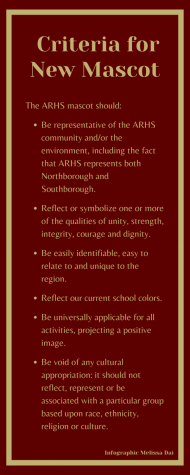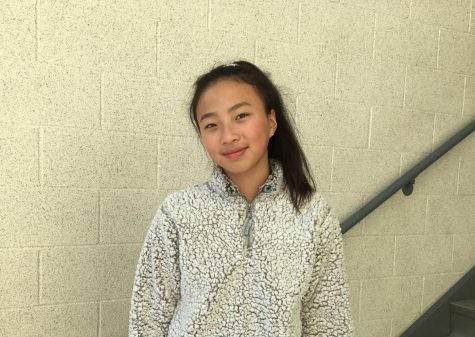A donation of $40 or more includes a subscription to the 2025-26 print issues of The Harbinger. We will mail a copy of our fall, winter, spring and graduation issues to the recipient of your choice. Your donation supports the student journalists of Algonquin Regional High School and allows our extracurricular publication to purchase equipment and cover our annual website hosting costs.
Mascot debate continues . . .
Renaming Study Group considers new mascot options, rejects Thunderhawk following retirement of Tomahawk
October 17, 2021
The Mascot Renaming Study Group has rejected the Thunderhawk as a replacement for Tomahawk as they continue to evaluate potential mascot suggestions against their list of criteria.
Last spring, the Regional School Committee (RSC) voted to officially retire the Tomahawk following the Mascot Study Group’s recommendation to do so, leaving the Algonquin community without a mascot for the first time in over 60 years. In the April 28 motion that retired the Tomahawk, the RSC also called for the formation of a Mascot Renaming Study Group.
“The committee members decided that a group should convene to make a decision about what the next mascot should be, and that that group should include a lot of different stakeholders from the community,” Principal Sean Bevan said.
When Assistant Superintendent of Operations Keith Lavoie was named the chair of the Study Group, he and Bevan worked together to identify 15 other individuals to join them in the renaming process. To ensure that the members of the group represented every key demographic in the ARHS community, they recruited eight students, one faculty member, two parents, one Booster Club member, two RSC members and Athletic Director Mike Mocerino. Each member plays

a vital role in the group.
“As a student representative, I mostly contribute what has been going on around school since administration doesn’t really know about that,” freshman Meredith Wu, a student member of the Study Group, said. “I basically relay others’ opinions about the mascot so that everyone else knows what the students are thinking about.”
“I represent the faculty of ARHS in this group, and as an alumnus of Algonquin and coach of both the football and baseball teams, I partially represent those groups as well,” Educational Support Professional Jonathan Cahill said.
Lavoie and Bevan found it essential that every opinion regarding the retirement of the Tomahawk was fairly represented in the group.
“There’s a range of perspectives in this group that are reflective of the community,” Bevan said. “There certainly are people in that group who previously were unhappy about the Tomahawk being retired, and I thought that it was important that they had a seat at the table to express themselves in the renaming process.”
So far, the Renaming Study Group has convened four times. The first two meetings took place over Zoom on July 13 and Aug. 16. According to Superintendent Gregory Martineau (who is not a member of the Study Group but plays an integral role in the discussion), these meetings were dedicated to creating a concrete set of guidelines for the new mascot.
“Much of the discussion was centered around aligning the next mascot to what the school’s core values are,” Martineau said. “A lot of time was spent on developing the criteria to vet any potential mascot suggestions against.”
Lavoie disclosed the final list of criteria in an email to the ARHS community on Aug. 18. Some of these criteria require that the new mascot “be void of any cultural appropriation” and “reflect or symbolize one or more of the qualities of unity, strength, integrity, courage and dignity” (see sidebar for full details).
With their guidelines established, the Renaming Study Group compiled a list of potential mascots, extracting several ideas from a survey Bevan distributed to all Northborough and Southborough residents on July 19. The previous mascot, the Tomahawk, was suggested 99 times, despite Bevan’s specific instruction that this was not an option. The Thunderhawk was mentioned in 67 responses, followed by the Hawks in 44 and the Eagles in 40. A total of 286 unique mascots were suggested, all of which can be found here.
During the third meeting on Sept. 20, members began to sort through this list, comparing each mascot option to the criteria and eliminating any, such as the Flame and the Buck, that did not match. The primary objective was to narrow the list down to a shortlist of two or three suitable options.
“The task is pretty simple: to use our criteria to filter through the suggestions and ideas that have come in,” Lavoie said. “What I really like about the group is that they’ve all had an open mind to all the options that are out there, but there’s also a keen awareness of what the criteria are and how we should use those criteria when choosing a mascot.”
To facilitate the process, Lavoie enlisted HEARD Strategy & Storytelling—an organization dedicated to guiding people through certain projects or processes—for help.
“HEARD Strategy has that experience of helping districts go through the renaming process, and the key point of what they do is take raw data from surveys, identify trends and look at the suggestions from another lens,” Lavoie said. “That third-party consultation has provided some nice background and good things to consider during the process, but they do not have a formal vote on which two to three mascots move forward for consideration.”
During the Sept. 20 meeting, the Thunderhawk, which has garnered considerable support in the community as a mascot option, was a primary focus of discussion.
“A lot of people seem to really like the Thunderhawk because we could still be the T-Hawks,” Wu said.
Members of the Study Group carefully deliberated this symbol, doing research and vetting it against the criteria. They quickly discovered that the Thunderhawk is a symbol with a Native American background, so Bevan consulted local Indigenous tribes, among them the Nipmuc Nation and the Narragansett peoples, over phone calls and via email for their opinions.
“I would discourage the use of the term ‘Thunderhawk,’” spokesperson for the Nipmuc Nation Brittney Walley said in an email to Bevan, which was made available to the community on Sept. 29. “Thunder Hawk is the name of not one, but two significant Native leaders. This would be the same as renaming the mascot with any Native leader, and would clearly be a continued use of Native imagery. In fact, usage of the term can lead to conflating more parts of Native history.”
“It is my opinion that one should stay away from anything that relates to Native American people, connotations or symbols if your organization/school is not Native American,” Chief Don Stevens, the leader of the Nulhegan Band of the Coosuk-Abenaki Nation, said in an email to Bevan, made available in the same document. “Otherwise, as you correctly identified, you will fall into the same problematic issue of perception.”
While one tribal leader, David Weeden of the Mashpee Wampanoags, did not object to the use of Thunderhawk, he deferred to the opinions of the Nipmuc peoples. Due to these responses, the group determined that the Thunderhawk is not a viable option for the new mascot in their most recent meeting on Oct. 4.
“Based on the research and conversations had with local Native American leaders, it does not seem appropriate to have Thunderhawk involved in the final choices,” Cahill said. “Part of our criteria is that the new mascot must be void of cultural appropriation. This was heavily discussed at our last meeting, and as a group, the consensus was to move past Thunderhawk as an option.”
According to Wu, there has been considerable debate around ARHS about the Thunderhawk and other potential mascots. At the same time, some community members are still expressing opposition to the results of the Tomahawk debate, especially on social media.
“Does anyone know how many proud Tomahawks left Algonquin and moved on to improve their lives, and can say the forces behind the Tomahawk were what drove them?” ARHS alumnus and Northborough resident John Fouracre said in a Sept. 18 Facebook comment on a Community Advocate article. “…Our history will never go away. It will always be there, and we are denying our future citizens the right to know and remember what it was like… Save the Tomahawks!”
However, Bevan emphasizes that the RSC’s unanimous (with one member not present) decision to retire the Tomahawk is final.
“I don’t take it lightly that the School Committee’s decision to retire the mascot was a really important one that required a lot of decisive, thoughtful deliberation,” Bevan said. “I’m certainly aware that there are high emotions on both sides of the debate about the retirement, but at this point, the retirement is complete, and now we’re focused on the renaming, which is an opportunity for us to unify and gather around a new mascot that represents everybody.”
To clear up some of the remaining questions and concerns circulating the community, Lavoie and Bevan distributed an FAQ document on Oct. 6.
“The FAQ that was sent out was just an effort to establish a uniform understanding of all the things that people are questioning,” Bevan said. “My only request to the people on all sides of the debate is that they remain educated and engaged so they can see that this decision was made with a great deal of thoughtfulness and research.”
Administrators are also devising new ways to address the concern that a new mascot would erase the school’s history.
“While we’re reviewing new mascots, we’re also working quietly on how to memorialize and remember our school’s history and our former mascot,” Bevan said. “For example, there’s a trophy case here in the F hallway that we’re going to convert into a physical, museum-style representation of Algonquin’s history, which will definitely represent the trajectory of the Tomahawk.”
Amid this ongoing controversy, the Renaming Study Group strives to remain focused on the task at hand.
“We realize that this is a sensitive topic, and that’s why we’re really taking our time to do it the right way to make sure that we aren’t leaving anything unconsidered,” Lavoie said.
The group’s next meeting is on Monday, Oct. 25. They will continue meeting until they finalize a shortlist of potential mascots, which they will then present to Martineau. After reviewing the shortlist, Martineau will relay the options to the RSC, allowing committee members to weigh in. Once the options are approved, current ARHS students will partake in a school-wide vote to officially select the new mascot.
“We want our new mascot to really stand the test of time,” Martineau said. “Symbols mean a lot of different things to a lot of different people, so we want to make sure that we vet the mascots that we bring forward to the School Committee through a rigorous process.”



Karen A Thornton • Dec 5, 2021 at 6:18 pm
The entire voting process in not inclusive of both towns. The final 5 are based off of a number that is a mere fraction of the The student body at ARHS, let alone the communities in which the name will represent. Why don’t we ask an Algonquin tribe what the name should be, or have a town voting day, advertise on local boards or on social media. Not just sending an email buried with spam and hundreds of other daily emails